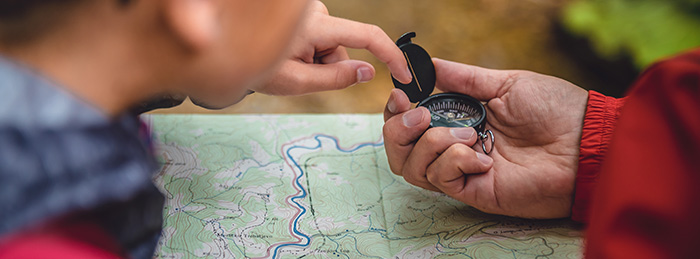Hiking Levels Explained: Safety and Technology Tips for Every Hiker
Hiking is a fantastic way to explore the great outdoors, offering a range of experiences from leisurely walks to challenging adventures. Whether you’re a beginner or an advanced hiker, having the right gear and knowledge is crucial to making your journey both safe and enjoyable.
The Importance of Being Prepared for Emergencies during Outdoor Adventures
Even the best-planned hikes can encounter unexpected emergencies. Common issues include sprained ankles, broken legs, and heart or breathing problems. These situations can escalate quickly, especially in remote areas without immediate access to help. Being prepared ensures that you can handle such incidents effectively, minimizing the risk and ensuring a prompt emergency response. Carrying the right equipment and knowing how to use it can make a critical difference in these hiking emergency situations.

Beginner-Level Hikes & Trails
Imagine setting off on a bright summer morning with your family, the sun shining, birds singing, and the trail promising a delightful adventure ahead. Beginner-level hikes typically feature easy terrain, moderate distances, and minimal elevation gain. How many miles is a beginner hike? How long does a beginner hike take? Beginner-level hikes are perfect for families with children, usually ranging from 1-4 miles, and can be completed in a few hours. Scenic overlooks, historical sites, or nature displays are typical examples, providing ample opportunities for rest breaks. Despite their simplicity, it’s essential to be prepared for any potential emergency situation.
Essential Gear & Tips for Hiking for Beginners:
- Clothing: Lightweight, breathable attire (moisture-wicking shirt and shorts/pants), sun hat or cap, UV-protective sunglasses, and hiking socks.
- Footwear: Sturdy hiking shoes with reliable traction.
- Backpack: Lightweight and breathable.
- Navigation: An area map (printed or digital), compass or GPS device, a smartphone with offline maps, and a fully charged battery (plus a portable charger).
- Hydration: Sufficient water; consider a hydration pack with a built-in reservoir.
- Nutrition: High-energy snacks (trail mix, energy bars), light meals or sandwiches, and electrolyte-replacement drinks.
- Sun Protection: Sunscreen with a high SPF, SPF lip balm, and lightweight, long-sleeved clothing.
- First Aid Kit: This kit includes basic supplies (bandages, antiseptic wipes, pain relievers), personal medications, and blister treatment.
- Emergency Supplies: Emergency whistle, multi-tool or knife, lightweight rain jacket or poncho.
Optional Gear for Beginner Level Hikes:
- Trekking poles for added stability.
- Bug repellent.
- Camera or smartphone for capturing memories.
- Portable charger for electronic devices.
Intermediate-Level Hikes
As your confidence and stamina grow, your level of hiking will change. Intermediate-level hikes offer a step up in challenge. These trails feature longer distances, varied terrain, and moderate elevation gains. Picture yourself navigating a 10-mile path winding through forests and gentle hills, offering breathtaking views and a rewarding sense of accomplishment. Intermediate hikes suit hikers with some experience and moderate fitness levels, typically taking several hours and potentially involving an overnight stay.
Additional Gear for Intermediate Hiking:
- Shelter: Lightweight tent, ground tarp, tent stakes, guy lines, sleeping bag, and sleeping pad.
- Cooking and Food: Lightweight stove, fuel, cooking utensils, biodegradable soap, and bear-proof food storage.
- Safety and Emergency: Headlamp or flashlight with extra batteries, personal locator beacon, or satellite communication device.
- Personal Items: Toiletries, trash bags, backpack rain cover, repair kit for gear, and bear spray.
Advanced-Level Hikes
What is considered an advanced hike? Advanced hikes provide the ultimate challenge for experienced hikers seeking a rigorous adventure. These trails often span significant distances (15-25 miles or more) and include steep ascents and rugged terrain, requiring a full day or multiple days to complete. Imagine standing atop a mountain summit after a demanding climb, with panoramic views as your reward.
Advanced Hiker Gear Suggestions:
- Clothing: Insulating layers (fleece or lightweight jacket), advanced waterproof and breathable rain jacket.
- Backpack: A high-capacity backpack suitable for multi-day hikes, with padded shoulder straps, a waist belt, and an adjustable torso length.
- Miscellaneous: Advanced trekking poles with shock absorption additional layers for changing weather conditions.
Safety Tips for All Hikers
Summer is a great time to get outdoors, but it’s important to keep safety top-of-mind. Emergencies can arise unexpectedly, regardless of your hiking experience. Proper preparation can significantly enhance your safety. It’s important to take precautions when hiking. Here are some essential safety tips for hiking:
- Plan Your Route or Trail: Always inform someone of your itinerary, including your starting point, route, expected return time, and planned stops.
- Pack Essentials: Carry water, food, navigation tools, a first aid kit, and suitable clothing for the weather.
- Stay on Marked Trails: Avoid venturing off established paths to reduce the risk of getting lost.
- Monitor Weather: Check forecasts and be prepared for sudden changes, packing extra layers and waterproof gear if necessary.
- Wildlife Awareness: Learn about local wildlife and how to respond safely if you encounter animals.
- Communications: Be sure to carry a fully charged cell phone, preferably one with access to satellite network connectivity to ensure you can call for emergency assistance should an accident or injury occur. Read more on Tech for hiking below:
Tech Enhancements for Hiking
Modern technology can greatly enhance your hiking experience and safety when hitting the trails this summer. Here are some must-have tech items for hikers of any level:
- Garmin GPS Devices: Reliable for navigation and tracking your hike.
- SPOT Gen4 Satellite GPS Messenger: You can communicate your location in areas without cell service.
- AllTrails App: Provides detailed maps, trail reviews, and offline map access.
- Lifestraw Personal Water Filter: Enables safe drinking from natural water sources.
Making Sure You’re Searchable and Locatable
Ensuring you can be found and assisted in a medical emergency is vital. Here are some steps and technologies to help you stay searchable and locatable:
- Share Your Itinerary: Inform a friend or family member about your hiking plans, including your starting point, route, expected return time, and planned stops.
- Carry a Personal Locator Beacon (PLB): Devices like the ACR ResQLink 400 send a distress signal with your location to emergency services when activated, which is crucial in remote areas without cell service.
- Use Satellite Communication Devices: The Garmin inReach Mini allows text messaging, location tracking, and SOS signals to emergency responders via satellite.
- Install Safety Apps: Apps like bSafe and Road ID allow real-time location sharing with designated contacts and offer panic button features that alert your contacts of your GPS location.
- Wearable Tech: Smartwatches with GPS capabilities, such as the Apple Watch Series 6 or Garmin Fenix 6, track your location and health metrics. Some models include emergency alert functions that notify your contacts if you fall or stop moving suddenly.
- Mark Your Trail: Use environmentally friendly trail markers or flags, especially if venturing off established trails, to aid search and rescue teams locate you more efficiently.
- Emergency Whistle: An emergency whistle can be vital. The sound carries much further than shouting and can help rescuers find you quickly.
A Note on PHI Air Medical
While PHI Air Medical is not a rescue service, it plays a crucial role in patient care during medical emergencies in remote areas. Called to the scene by qualified emergency personnel, PHI Air Medical provides timely medical attention and transportation when needed, ensuring patients receive high-quality care enroute to medical facilities.
Join PHI Cares – An Air Ambulance Membership Program
Consider joining PHI Cares, the air ambulance membership program of PHI Air Medical. For an small, annual fee, PHI Cares protects your entire household from incurring out-of-pocket costs if flown by PHI Air Medical during a medical emergency. Our air ambulance insurance program offers peace of mind, knowing that you and your loved ones are covered in critical situations. Be safe while hiking and know you are protected from out of pocket costs should the need to be flown from the trail arises.
Whether planning a leisurely hike or an advanced adventure, staying safe and prepared is key. Equip yourself with the right gear, leverage the latest technology, and consider the benefits of PHI Cares membership for emergency medical protection. Happy hiking!



